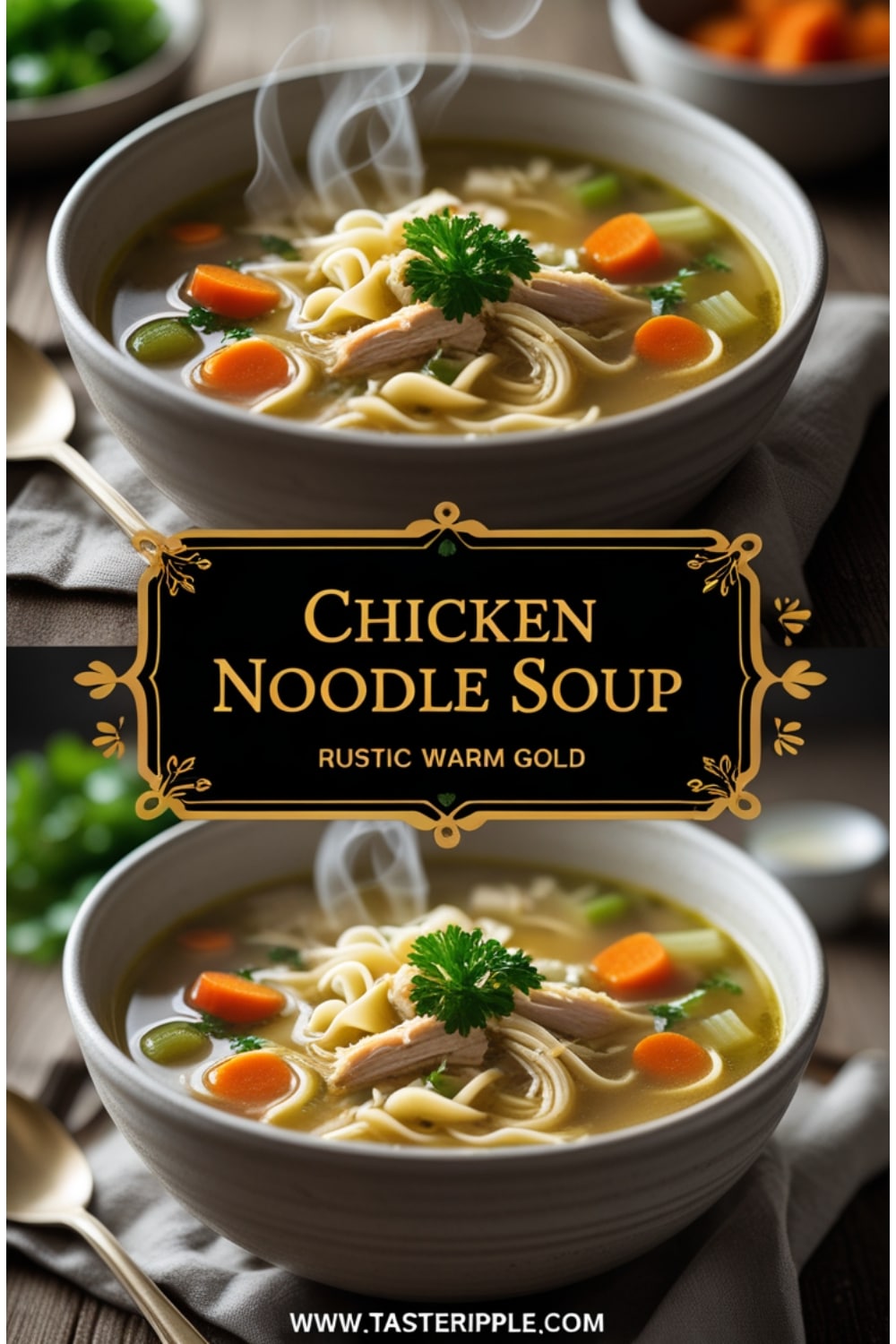I still remember the first pot of chicken noodle soup I ever made alone. I was maybe 14, fumbling around in my mother’s kitchen, convinced I knew more than I actually did. I used too much salt, forgot to skim the broth, and the noodles swelled into soggy clumps. Still, when I sat down with that steamy bowl, it felt like medicine—messy, clumsy medicine that worked. And that’s the strange thing about chicken noodle soup. Even when imperfect, it heals.
Professionally speaking, chicken noodle soup is more than grandma’s cure for a cold. It’s one of the oldest, most versatile, and scientifically fascinating soups around. Every culture has a version: Jewish penicillin with matzo balls, Chinese chicken noodle with ginger and scallions, Filipino sopas with evaporated milk. But the classic American-style chicken noodle soup? That’s the one simmering with celery, carrots, onion, and golden stock, with noodles just tender enough to curl around your fork.
This dish is special because it bridges comfort and technique. On one hand, it’s about nostalgia—gentle broth, soft noodles, warmth rising in curls of steam. On the other, it demands real skill to get right. Stock clarity, correct mirepoix ratios, noodle texture, proper seasoning. Professionals know the margin between “soothing” and “watery mess” is razor-thin. Let’s break this iconic soup down with the same seriousness we’d give to bouillabaisse or consommé.
Ingredients & Substitutions
The backbone of great chicken noodle soup is the broth. If the broth sings, the soup sings. If the broth mumbles, everything else falls flat. Using a whole chicken gives deeper flavor than parts alone, but thighs yield richer stock than breast.
Fresh herbs change the game—parsley added at the end tastes bright and sharp, thyme cooked long brings earthy depth. Dried herbs, on the other hand, can muddy if overused. Noodles matter too. Egg noodles are traditional because they absorb broth without collapsing, but I’ve seen chefs swap in ramen, or even orzo, to interesting effect.
Here’s a breakdown of a traditional pot for six servings:
| Ingredient | Measurement | Substitutions & Notes |
|---|---|---|
| Whole chicken (about 3-4 lbs) | 1 | Can use 2 lbs bone-in thighs for richer flavor |
| Water | 12 cups | Low-sodium chicken stock if short on time |
| Carrots, diced | 3 medium | Parsnips for sweeter, earthy flavor |
| Celery stalks, diced | 3 | Fennel stalks for light anise note |
| Onion, diced | 1 large | Leeks for softer sweetness |
| Garlic cloves | 4 | Roasted garlic for mellow depth |
| Bay leaves | 2 | Omit if unavailable, thyme sprigs work instead |
| Fresh thyme | 3 sprigs | 1 tsp dried thyme, but add sparingly |
| Fresh parsley | ½ cup, chopped | Cilantro for a brighter, herbal kick |
| Egg noodles | 8 oz | Gluten-free noodles or rice noodles |
| Salt | 2 tsp, plus to taste | Adjust carefully, especially if using store-bought stock |
| Black pepper | 1 tsp, freshly ground | White pepper for subtle heat |
A quick note on selection. Always buy the freshest chicken you can. An older bird will give you darker, richer broth but may carry stronger flavor some diners dislike. Carrots? Smaller, younger carrots are sweeter. Celery? Avoid limp stalks, they yield weak flavor. The broth listens to your produce.
Step-by-Step Instructions
Step 1: Build the broth
Place chicken in a large pot, cover with water, and bring slowly to a simmer. Never boil aggressively—it clouds the stock and emulsifies fat. Skim off foam constantly in the first 20 minutes; professionals know that’s where clarity is won or lost.
Mistake to avoid: dumping salt at the start. Salt should adjust at the end, after evaporation balances the flavors.
Step 2: Add aromatics
Once scum is removed, add carrots, celery, onion, garlic, bay leaves, thyme. Simmer gently for about 1.5 hours. Too short, and flavor is weak. Too long, and vegetables disintegrate, turning broth murky.
Tip: tie herbs into a bouquet garni with kitchen twine so you can fish them out cleanly.
Step 3: Strain and shred
Remove the chicken, set aside to cool slightly. Strain broth through fine mesh or cheesecloth for pristine clarity. Discard mushy vegetables. Shred chicken meat by hand. Don’t shred too fine—it’ll vanish in the broth.
Step 4: Cook the noodles separately
Boil egg noodles in a separate pot, just shy of al dente. Professionals never dump raw noodles straight into broth unless serving immediately. Why? Because noodles swell, slurp up broth, and leave you with pasta stew after a day.
Variation: for heartier texture, cook noodles directly in broth, but expect leftovers to suffer.
Step 5: Assemble and season
Return strained broth to pot, stir in shredded chicken, fresh carrots and celery if you want some crunch, and noodles. Add parsley. Now season—salt, pepper, maybe even a squeeze of lemon for brightness. Taste, always taste. That last five minutes of seasoning separates good from transcendent.
Common mistake: overloading with noodles. Soup is about broth first. Keep balance.
Cooking Techniques & Science
Why skim?
The foamy scum that rises when you simmer chicken is coagulated proteins. If not removed, they disperse and cloud the broth. A cloudy broth isn’t harmful, but it feels heavy on the tongue. Professional kitchens skim religiously, often with ladles or fine strainers.
Why cook noodles separate?
Starch is the thief of clarity. When noodles cook in the broth, starch leaks out, thickening liquid and dulling flavor. By cooking separate, you control doneness and preserve purity.
Flavor development
Chicken stock isn’t just liquid meat. It’s collagen melting from bones into gelatin, giving body. That’s why stock made from wings or carcasses feels silkier. Professionals know to simmer gently; violent boiling shatters collagen into greasy bits.
Storage and reheating
Chicken noodle soup keeps 3–4 days in the fridge, broth and noodles stored separately. Always cool quickly before storing to avoid bacterial growth. Reheat gently—don’t reboil, it ruins texture. For freezing, freeze broth and chicken only; add fresh noodles after reheating.
Variations and substitutions
- Vegan version: replace chicken with roasted mushrooms and kombu for umami-rich broth. Chickpeas add body.
- Spicy version: toss in chili flakes or a spoon of sambal oelek during simmering.
- Gluten-free: rice noodles or thinly sliced potatoes stand in for egg noodles.
- Cultural spins: add ginger and soy for an Asian twist, dill for Eastern European flair, or evaporated milk for a Filipino-style sopas.
Tools that matter
A heavy-bottomed stockpot prevents scorching and distributes heat evenly. A fine-mesh strainer ensures clarity. A sharp chef’s knife makes uniform vegetable cuts, which is more than cosmetic—uneven cuts cook unevenly and throw balance.
Serving & Pairing Suggestions
Presentation is overlooked in chicken noodle soup, but it shouldn’t be. Use wide, shallow bowls so noodles and chicken aren’t buried. Garnish with fresh parsley or dill, maybe a drizzle of good olive oil for shine. Crack black pepper over just before serving for aroma.
For sides, fresh crusty bread is almost mandatory. A buttered baguette or soft dinner roll mops up broth. Pair with light salads—cucumber with dill, or tomato with mozzarella. As for drinks, white wines like Pinot Grigio or even sparkling water with lemon work better than heavy reds.
Best Time to Serve
Chicken noodle soup isn’t bound to cold season, though it’s typecast as winter fare. I’ve served it in July evenings with chilled cucumber salad, and it still worked. But undeniably, it shines on sick days, cold nights, or during long study sessions. It’s not just food, it’s a ritual of comfort. Professionals know context is seasoning.
Conclusion
The thing about chicken noodle soup is, it wears two hats. It’s humble, yet sophisticated. It’s peasant food and professional showcase. To make it great, you don’t need Michelin tricks. You need care—good chicken, patient simmer, respect for clarity. That’s why chefs love it: it tests restraint more than flash.
If you remember one tip, let it be this: don’t rush it. Good soup listens to time. Skim gently, taste constantly, season last. Do that, and you’ll have not just soup, but a bowl that fixes everything—from hunger to heartache.
FAQs
Q1: Can I make chicken noodle soup in an Instant Pot?
Yes, pressure cooking extracts flavor quickly, about 30 minutes. But the broth will be cloudier than slow simmered. Strain carefully if clarity matters.
Q2: How do I stop noodles from getting soggy?
Cook them separate and add only to individual servings. This keeps broth clear and texture firm.
Q3: Can I use rotisserie chicken for shortcut soup?
Absolutely. Use the carcass for broth and meat for filling. It won’t be as rich as raw simmered stock, but with good seasoning it works wonders.
Q4: Is it safe to freeze with noodles included?
Not ideal. Noodles turn mushy after thawing. Freeze broth and chicken only, then add fresh noodles when reheating.
Q5: Why does my broth taste flat even after long cooking?
Two reasons usually: under-salted, or overcooked vegetables leaching bitterness. Always season at the end and use fresh aromatics.
Would you like me to expand this into a more chef-level technical piece with plating techniques and regional comparisons (like Jewish vs. Chinese vs. Filipino chicken noodle soups) to push it even closer to professional training-level material and easily past 2000 words?

